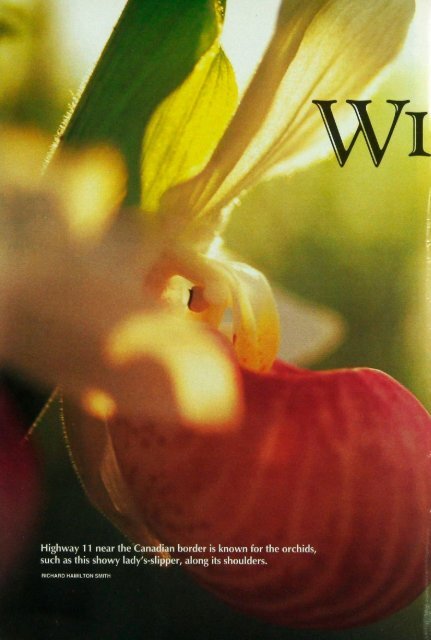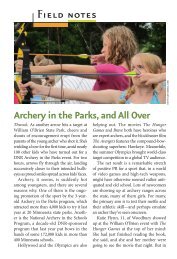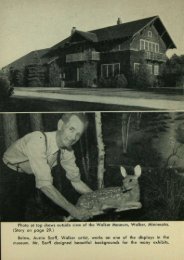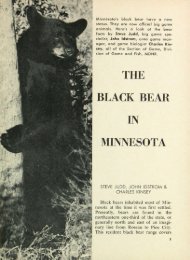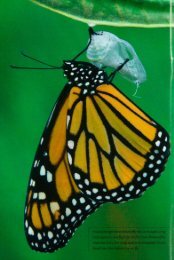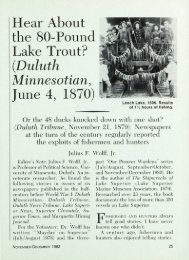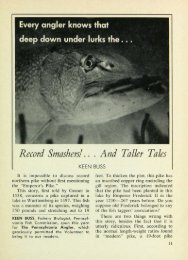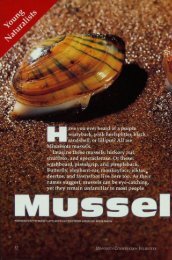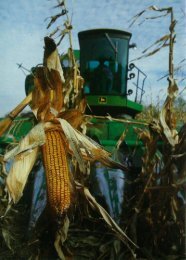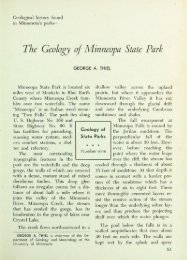306 Can This Wildflower Route Be Saved? - webapps8
306 Can This Wildflower Route Be Saved? - webapps8
306 Can This Wildflower Route Be Saved? - webapps8
- No tags were found...
Create successful ePaper yourself
Turn your PDF publications into a flip-book with our unique Google optimized e-Paper software.
Highway 11 near the <strong>Can</strong>adian border is known for the orchids,such as this showy lady's-slipper, along its shoulders.RICHARD HAMILTON SMITH
CAN THISLDFLOWERROUTEAVED?By MARGARET A. HAAPOJAVolunteers make a last'ditch effort to rescue nativeorchids in the path of roadwork.PAUL RUNDELL REMEMBERS WHEN ORCHIDS GREW LIKE DANDELIONS ALONGHighway 11 between Baudette and Greenbush along the <strong>Can</strong>adianborder. The retired park resource specialist for the Department ofNatural Resources once estimated 2 million to 5 million orchids grew there,including about 800,000 showy lady's-slippers, the state flower. Indeed,orchids were so profuse that in 1990 Gov. Rudy Perpich designated thatstretch of Highway 11a Minnesota <strong>Wildflower</strong> <strong>Route</strong>, one of the first of fivesuch routes in the state. Since then, the Williams Garden Club has hosted anannual <strong>Wildflower</strong> <strong>Route</strong> Celebration every year in mid-June. Led by localwildflower advocate Celeste La Valla, club members flag some 40 differentwildflower species in the area and provide maps for enthusiasts searchingfor the flowers.The roadway is so unusual and beautiful that it is no wonder area residentswere upset when road construction threatened to destroy their "orchid highway."LaValla still mourns the loss of so much wildflower habitat. "If you
Orchid Relocationshoot an eagle, you'll be punished forit," she says. "What's the differencewhen you rip up the whole road withall our orchids? It's our state flower."After seeing orchids plowedunder during the first two sectionsof road construction, La Valla andGretchen Mehmel began a crusadeto rescue native lady's-slippers fromthe bulldozers in the final constructionphase between Williams andRoosevelt. Schoolchildren and BoyScouts, tourists and senior citizens,Sentence to Service crews, and theMinnesota Conservation Corps participatedin several digs, beginningin September 1997 and continuingthrough 1998. More than 150 peoplehelped with the first dig, saidLa Valla, who owns a flower shopand greenhouse in Warroad. "Theycame from all over the state, fromMinneapolis to Alexandria and fromFargo to Duluth."The volunteers dug up about10,000 plants from the roadside intwo days and transplanted theminto furrows plowed in a field nearWilliams, said Mehmel, manager ofthe Red Lake Wildlife ManagementArea, who coordinated the projectwith LaValla. The transplantsSTEVE MORTENSENjt'-sksip
flowers were Scenic, Itasca,Zippel Bay, Lake <strong>Be</strong>midji,and Hayes Lake.Volunteers (left) have transplantedorchids such as small yellow lady'sslippers(above) in an attempt to savethem from roadwork along Highway 11.thrived and awaited their return totheir roadside home when constructionwas complete. In September1998, after the new highway wasfinished, a handful of local volunteersmoved about three-quarters ofthe plants back to the roadside. Therest of the plants will be returnedwhen they flower this June.Many plants traveled to stateparks. Volunteer Anne Smithmoved about 300 plants to Old MillState Park near her hometown ofWarren. "When I found out I couldgive others the chance to see theshowy and yellow lady's-slippers,"she said, "I seized the opportunity."Other state parks receiving theEYE-OPENER, steveBorough brought his Sentenceto Service youth, 14- to16-year-olds fulfilling theircourt-ordered communityservice for minor offenses, tohelp with the digs. "It wasquite an eye-opener for myyoung people," he says."Some of them said they'dlived here all their lives, andyet they'd never seen theorchids bloom. <strong>This</strong> projectgives them a sense of pride. Itell them they can come back andsay they helped save these flowers."Sid and Nancy Marler came fromChattanooga, Tenn., for the Williams<strong>Wildflower</strong> <strong>Route</strong> Celebration andspent five hours helping to moveorchids.<strong>Be</strong>th Siverhus and her 12-year-olddaughter, Emily, participated in thedig; for them it was a learningexperience. They learned that someplants with 20 or more orchids arethought to be 100 years old. <strong>Be</strong>thsays, "Any person who has drivenalong Highway 11 betweenBaudette and Warroad when theyellow and showy lady's-slippersare in full bloom would understandwhy such an effort is being made tosave them."To satisfy state law, volunteersapplied for and received a permitM AY-JUNE 1999 13
LIMITS OF ROADWORKIs SAVING ROADSIDE WILDFLOWERS REAL CONSERVATION ?The key to saving wildflowers is habitatprotection. In some counties roadsides providethe last remaining examples of native habitats.Unfortunately, roadside habitats are vulnerableto routine mowing and herbicide applications,as well as roadway upgrades. In some cases,sunny roadside habitats mimic naturalopenings that occurred historically as a result offire or windstorms. Species adapted to thosenatural disturbances might be suited forpreservation in roadsides, provided they aremanaged in ways that are compatible with thespecies' life history.Preserving habitats is critical, but legalprotection is also important. The commercialwildflower and medicinal plant trade poses athreat to specific species, including lady'sslippers,prairie coneflower, ginseng, goldenseal,and princess pine. Laws are designed to protectwild rice and ginseng from overharvest.The 1930 wildflower law, administered by theMinnesota Department of Agriculture, prohibitsselling all orchids, gentians, lotus, trailingarbutus, and trilliums collected on public land oron private land without the owner's writtenconsent. Minnesota's endangered speciesstatute, administered by the DNR, protects 123flowering plant species. <strong>This</strong> act prohibits taking,importing, transporting, or selling any portion ofa state endangered or threatened species. It isadvisable to read the full text of the statute tounderstand all regulations and exemptions thatapply to species designated under the state law.The federal Endangered Species Act of 1973protects four Minnesota plant species onfederally owned land and anywhere else,including roadsides and private lands, beingimpacted by projects that require federalpermits or receive federal funding.NANCYDNRSATHERbotanistfrom the MinnesotaDepartment of Transportationfor access tothe right of way. <strong>This</strong>permit waives any liabilityfor the stateagency. Other state andfederal laws addresswildflower protection(see sidebar on thispage).STATE LAWS."There really aren'tany solid statutes thatprevent a departmentlike the MinnesotaDepartment of Transportationfrom impactingthings like this,"says Bob Jacobson,MnDOT botanist andplant ecologist. "Evenspecies protected bystate law have no14
ights in the rights of way. The lawwas written to exempt roadauthorities."Over the years, railroad andhighway maintenance practices ledto optimum conditions for thenative orchids, according toJacobson. "You have the wet soils,and you also have the railroadkeeping the trees and brush backby prescribed burning," he says."That's kept those areas open forthe orchids."As part of the construction project,MnDOT crews took care tosegregate the topsoil and put itback where it came from. "WeOrchids (right) are moved to a temporarynursery area as the roadside Sis graded. MnDOT is temporarilyrolling back sod and topsoilJ(below), and then moving them Iback into place when work is done £to try to keep existing seeds andplants in place. £pulled it back and replaced itquickly, so we wouldn't composteverything," Jacobson explains.The crew also reseeded withnative plants. "I think much ofwhat will be there in 20 years willbe what comes back from the seedbank that's present in the soil."According to former MnDOTcommissioner Leonard W. Levine,improvements for Highway 11 hadbeen considered for more than 20years. With the expansion ofMarvin Windows in Warroad and
The large yellow lady's-slipper and showy lady's-slipper are two of the mostspectacular of Minnesota's 42 native species of orchids.the seed potato industry in theWilliams area, highway traffic increased,and so did the need for roadimprovements. A study of the highwayidentified low load-carryingcapacity, narrow shoulders, steepslopes, and bad culverts.Rundell admits the road reconstructionwas necessary. "The roadwas getting to the point where itwas dangerous for people to travelon it," he says. "That real steepMargaret A. Haapoja is a free-lancewriter from rural Bovey.ditch, no shoulders, and increasedtraffic they've got now with all thebusinesses up there—it was scaryon that road."The several-year project addedpavement strength, 5-foot-wideshoulders, and flatter slopes to allowrecovery if a vehicle goes off the road.GAUDY ORCHIDS. THEHighway 11 corridor contains largeand small yellow lady's-slippers andshowy lady's-slippers, by far themost spectacular lady's-slipper."Biologically, they are very similar16 MINNESOTA CONSERVATION VOLUNTEER
| to the other lady's-slippers, but whatg is unique about them is their appear-§ ance," says DNR botanist WelbySmith, whose book Orchids of Minnesotais the definitive text on the topic."People like the really showy, gaudyorchids. When they see them, folksjust stop and gasp. Most people reactjust to the pure emotional appeal oftheir appearance."Minnesota's 42 native orchids arepart of one of the world's largestplant families, with 20,000 to 23,000species. Orchids probably grow inevery county in the state and inevery terrestrial habitat type, saysSmith. Yet he warns, "The orchidswe enjoy today may be gone tomorrow.About 75 percent of orchidhabitats statewide have disappeared,and losses continue."The showy lady's-slipper is sometimescalled the pink-and-whitelady's-slipper for its large, white lipmarked with pink or purple. Theplants are tall, sometimes growingto 3 feet. According to Smith, onelady's-slipper flower can produceclose to a million seeds. "They'revery tiny," he says. "They're justlike dust or finely ground peppergrains."Long-lived and slow to develop,showy lady's-slippers require 10 to15 years from seed germination toflowering in the wild. These orchidsgrow in shade or direct sunlight.They prefer organic or mineral soilsthat are weakly acidic or neutral andmoist but not wet.Smith describes a symbioticassociation between lady's-slippers
Orchid Relocationand soil fungi called a mycorrhizalrelationship. "There are thousandsof species of mycorrhizal fungi thatform these relationships with vascularplants. Orchids are notoriousfor relying on this relationshipvery heavily," Smith says. "Theycouldn't live without it." <strong>Be</strong>causeorchid seeds are so small, they areall embryo with no endosperm.They derive their food supply fromthe soil fungi on which they areactually a parasite for severalyears while they're developingtheir own system.UNCERTAIN FUTURE.Opinions differ on whether the borderlandorchid relocation effortswill be successful. Smith isn't optimistic."It's not a situation that'sripe for success," he says, "simplybecause the plants are too hard totransplant. It's not the way you'd goabout doing it if you had a totallyfree hand. The habitat that theyhave been in for all these years waspretty stable, had all the complementof associated species, all thepollinators, and all the soil fungiand all the soil structure."Then when they come in withroad graders, it's basically all goingto be scraped clean. What they'regoing to end up with when they putthe plants back is going to be justraw dirt; none of that habitat isgoing to be there. It's going to bepretty harsh there. They will have alot of competition with plants theyhaven't had to compete with before.It's sort of like going into a forestand taking a pair of bald eagles outof their nest and coming with bulldozersand leveling the whole forest.Then you put the eagles back onthe ground and say, 'Here's yourhabitat again.'"Others are more hopeful. MnDOTtechnician Mark Hovdestad, whohas supervised several orchid digsover the years, reports 75 percentsurvival of orchids transplantedfrom the area between Pitt andWilliams back in 1988. "We hadalmost 100 percent survival of theplants we moved into a big field upat Zippel Bay State Park," he says."We only found three bunches thatdidn't make it out of 750 that wemoved in there." The questionremains: Will the plants survivetheir next move?Janet Boe, DNR regional plantecologist, sees the orchid rescue asan opportunity to discover whethernative orchids can be transplantedsuccessfully. "Orchids are suchstrange plants," she says. "Theydon't behave like many plantswe're more familiar with. They'retouchier."While no one suggests that transplantingorchids adequately compensatesfor destroying existinghabitat, boosters of the Highway11 wildflower route hope thattransplanting will at least protectthe beauty of a popular orchidshowcase. "The state designated it18 MINNESOTA CONSERVATION VOLUNTEER
a wildflower route, and they couldundesignate it," says BonnieSchuh, who has lived in the areasince 1954 and participated in severalof the digs. "We want to preserveit if we can." •For information on the Williams <strong>Wildflower</strong><strong>Route</strong> Celebration June 19, call218-386-2744. Orchids of Minnesotais available at bookstores or by callingMinnesota's Bookstore, 651-297-3000or toll-free 800-657-3757.Yellow lady's-slippers returned to a roadside ditch in an earlier transplanting effortappear to have survived. The long-term prognosis for relocated orchids is stillunclear. A better conservation strategy is protecting flowers in wild habitats.


